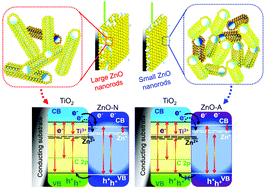The formation of heterostructures is one of the most recognized alternatives to improve visible-light absorption and carrier mobility in metal oxide-based composite photoanodes. Despite this fact, how the precursor nature influences photoanode preparation with respect to the abovementioned performance behavior has not been deeply elucidated. Aiming to clarify the role of the synthesis precursors in the crystal growth during the formation of metal oxide-based heterostructures, we studied the morphology and photoelectrochemical (PEC) performance of ZnO nanorod/TiO2 nanoparticle based thin films obtained by the sol–gel method. By using zinc nitrate (N) and zinc acetate (A) as precursors for ZnO nanorod preparation, ZnO-N/TiO2 (N-ZT) and ZnO-A/TiO2 (A-ZT) based n–n type heterojunctions were established, where the growth of the ZnO nanorods depended on the used precursor anion. By using the inorganic precursor, large ZnO nanorods were formed containing a high Zn+ electron donor density. This allowed the carrier flow into the N-ZT film, also supported by a high density of Ti3+ species. Conversely, small ZnO nanorods were produced with the use of organic precursor, as a result of Zn2+ dissolution during ZnO formation. This induced the decrease of Zn+ and Ti3+ content in the A-ZT film. Additionally, Zn2+ thermally diffused from ZnO to TiO2, promoting the Zn2+-doping of TiO2 and increasing the amount of interfacial and acceptor energy levels in both the N-ZT and A-ZT films. Nonetheless, the donor energy level content was higher in the former material, which facilitated charge carrier separation and transport. Therefore, an improved electron lifetime and a lowered recombination rate were achieved.

